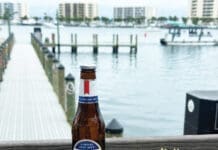By Rita L. Sherwood
 Starting their sixth season of monitoring and protecting our local area’s precious sea turtles, dynamic father/daughter duo George and Sara Gray continue their labor of love with the Emerald Coast Turtle Watch organization. George founded the Emerald Coast Wildlife Refuge 12 years ago, and was also the Gulfarium’s show director for 20 years. He had an idea six years ago to do a turtle watch and teach a sea turtle conservation class, and that’s how the Emerald Coast Turtle Watch began.
Starting their sixth season of monitoring and protecting our local area’s precious sea turtles, dynamic father/daughter duo George and Sara Gray continue their labor of love with the Emerald Coast Turtle Watch organization. George founded the Emerald Coast Wildlife Refuge 12 years ago, and was also the Gulfarium’s show director for 20 years. He had an idea six years ago to do a turtle watch and teach a sea turtle conservation class, and that’s how the Emerald Coast Turtle Watch began.
In case you don’t know, Florida beaches are the No. 1 place for sea turtle nests in North America from May to October. Northwest Florida beaches attract many endangered species including Green, Loggerhead, Leatherback and Kemps Ridley. A female will return to the beach where she was born to lay her eggs.
You will find George and Sara beginning the first Tuesday and Wednesday in June teaching all about how to protect this natural happening at 7:30 p.m., weekly until the end of October. (Nesting season in our area runs May 1-October 31, although in some areas of Florida, it begins in March.) Simply meet at the Okaloosa Island fire station to participate in a class which teaches about our beloved sea turtles, then after, follow them on a beach walk, to observe a sea turtle’s nest. And if you’re lucky, maybe even watch a nest hatch, revealing anywhere from 80-140 tiny little sea turtle babies racing their way to the Gulf of Mexico.
What’s the most important thing to remember if you see a mama sea turtle on the beach? Sara says, “Be respectful, stay quiet and stay back at least 50 feet. Don’t get excited or be loud or take pictures with the flash on your cell phone which disorient the turtles and stress them out. They return to the water unable to lay their eggs.” Sea turtles need the dark and also calmness when laying their eggs.
“If you’re lucky enough to see it, it’s incredible to watch a 300-400 lb. Loggerhead sea turtle crawl up the beach which is no easy task, dig an 18-20 inch hole with only her back flippers, deposit her eggs, and then cover them back up with sand and pat it all down (all with only her back flippers). The whole process takes 30 to 60 minutes.
Then 40-60 days later, the Emerald Coast Turtle Watch comes in by monitoring the nest, and ensuring the turtle hatchlings make it safe into the water. Sea turtles can live to be over 100 years old, but unfortunately only one hatchling in a thousand makes it to adulthood (15-25 years). There are many hazards and further complications if a sea turtle hatches during the daytime.. For example, a sea gulls’ favorite snack is a baby sea turtle. The nest, also, is at risk of predation by animals as well as of high tides during storms, which can wash out and drown nests. Once hatched, they must make it to the water without becoming disoriented by artificial light or killed by predators. Finally, they arrive to their home in the Gulf where they are at risk of sharks, fish, fishing lines, ingesting debris and trash, boats and pollution. For the females who survive and return to shore to nest, it is a great victory. By the way, once she lays her eggs on the beach, the sea turtle mama never returns.
And how do you know if you come across a sea turtle nest on the beach? “Usually from the tracks from the turtle crawling up the beach, or from a concave shape in the sand,” Sara says.
Also, Sara encourages all of us locals (and visitors) to continue to clean up the beach, especially the straws and plastic bags which can harm the sea turtles, as well as other wildlife. Plastic bags in particular, look like jellyfish to the turtles and they try to eat it, which causes them great harm.
If you’re interested in learning more about sea turtles and would like to attend a class and see a nest, go online to fill out an application at Emeraldcoastfl.com click on Explore, then Ecotourism and then Beach Walks, or visit the Facebook page.
How You Can Help
Limit lights at night: If you live or are staying at a Gulf-front property, keep the lights off on the balcony and close curtains/blinds during turtle season.
Use turtle safe flashlights or flashlight covers when on the beach at night.
Fill in any holes you dig and smooth out sandcastles when you leave the beach each day.
Remove all belongings and trash from the beach every day.
Do not release helium balloons, which end up in waterways where sea turtles confuse them for their favorite food—jellyfish.
Report any sea turtle activity to the Emerald Coast Turtle Watch Emeraldcoastfl.com.
































































